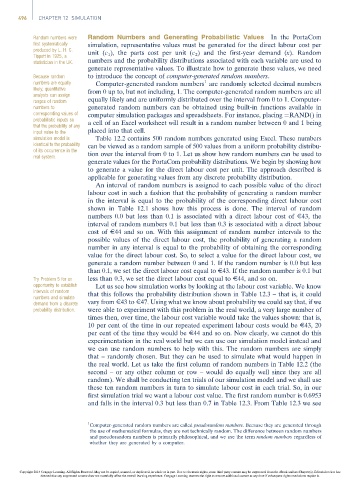Page 516 -
P. 516
496 CHAPTER 12 SIMULATION
Random numbers were Random Numbers and Generating Probabilistic Values In the PortaCom
first systematically simulation, representative values must be generated for the direct labour cost per
produced by L. H. C.
Tippett in 1925, a unit (c 1 ), the parts cost per unit (c 2 ) and the first-year demand (x). Random
statistician in the UK. numbers and the probability distributions associated with each variable are used to
generate representative values. To illustrate how to generate these values, we need
Because random to introduce the concept of computer-generated random numbers.
1
numbers are equally Computer-generated random numbers are randomly selected decimal numbers
likely, quantitative from 0 up to, but not including, 1. The computer-generated random numbers are all
analysts can assign
ranges of random equally likely and are uniformly distributed over the interval from 0 to 1. Computer-
numbers to generated random numbers can be obtained using built-in functions available in
corresponding values of computer simulation packages and spreadsheets. For instance, placing ¼RAND() in
probabilistic inputs so
that the probability of any a cell of an Excel worksheet will result in a random number between 0 and 1 being
input value to the placed into that cell.
simulation model is Table 12.2 contains 500 random numbers generated using Excel. These numbers
identical to the probability can be viewed as a random sample of 500 values from a uniform probability distribu-
of its occurrence in the
real system. tion over the interval from 0 to 1. Let us show how random numbers can be used to
generate values for the PortaCom probability distributions. We begin by showing how
to generate a value for the direct labour cost per unit. The approach described is
applicable for generating values from any discrete probability distribution.
An interval of random numbers is assigned to each possible value of the direct
labour cost in such a fashion that the probability of generating a random number
in the interval is equal to the probability of the corresponding direct labour cost
shown in Table 12.1 shows how this process is done. The interval of random
numbers 0.0 but less than 0.1 is associated with a direct labour cost of E43, the
interval of random numbers 0.1 but less than 0.3 is associated with a direct labour
cost of E44 and so on. With this assignment of random number intervals to the
possible values of the direct labour cost, the probability of generating a random
number in any interval is equal to the probability of obtaining the corresponding
value for the direct labour cost. So, to select a value for the direct labour cost, we
generate a random number between 0 and 1. If the random number is 0.0 but less
than 0.1, we set the direct labour cost equal to E43. If the random number is 0.1 but
Try Problem 5 for an less than 0.3, we set the direct labour cost equal to E44, and so on.
opportunity to establish Let us see how simulation works by looking at the labour cost variable. We know
intervals of random that this follows the probability distribution shown in Table 12.3 – that is, it could
numbers and simulate
demand from a discrete vary from E43 to E47. Using what we know about probability we could say that, if we
probability distribution. were able to experiment with this problem in the real world, a very large number of
times then, over time, the labour cost variable would take the values shown: that is,
10 per cent of the time in our repeated experiment labour costs would be E43, 20
per cent of the time they would be E44 and so on. Now clearly, we cannot do this
experimentation in the real world but we can use our simulation model instead and
we can use random numbers to help with this. The random numbers are simply
that – randomly chosen. But they can be used to simulate what would happen in
the real world. Let us take the first column of random numbers in Table 12.2 (the
second – or any other column or row – would do equally well since they are all
random). We shall be conducting ten trials of our simulation model and we shall use
these ten random numbers in turn to simulate labour cost in each trial. So, in our
first simulation trial we want a labour cost value. The first random number is 0.6953
and falls in the interval 0.3 but less than 0.7 in Table 12.3. From Table 12.3 we see
1
Computer-generated random numbers are called pseudorandom numbers. Because they are generated through
the use of mathematical formulas, they are not technically random. The difference between random numbers
and pseudorandom numbers is primarily philosophical, and we use the term random numbers regardless of
whether they are generated by a computer.
Copyright 2014 Cengage Learning. All Rights Reserved. May not be copied, scanned, or duplicated, in whole or in part. Due to electronic rights, some third party content may be suppressed from the eBook and/or eChapter(s). Editorial review has
deemed that any suppressed content does not materially affect the overall learning experience. Cengage Learning reserves the right to remove additional content at any time if subsequent rights restrictions require it.

